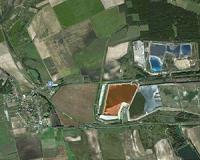| . |  |
. |
Bratislava (AFP) Oct 19, 2010 Slovakia might face a similar devastating toxic sludge spill that hit neighbouring Hungary two weeks ago, the environment ministry said Tuesday after checking the country's 28 sludge reservoirs. "The toxic waste reservoir in the eastern Slovak municipality of Slovinky is in a bad condition and heavy rains might increase the risk of an environmental disaster," the ministry said on its website. Local media have reported that if the 113-metre-high (123 yard) dam burst, hundreds of thousands of tonnes of toxic sludge could flood houses in nearby villages to the height of three metres. The company which owns the reservoir has gone bust and does not have the money to take the necessary security steps, the ministry said, adding it would try to use European Union funds to repair it. "The waste in the reservoir is solid and it would take unusually heavy rains for the sludge to become liquid and possibly break the dam," the ministry's geology expert Vlasta Janova told AFP. The remaining 27 reservoirs in Slovakia -- including the one in Horna Ves in central Slovakia which burst in 1971 -- are safe, the ministry's report said.
earlier related report MAL Hungarian Aluminium Production and Trade Company "would be prepared to pay 1.5 billion forint (5.5 million euros) over five years by way of compensation for the victims of the toxic sludge catastrophe two weeks ago," said the company's chief Lajos Tolnay. "Even if it is not possible to say yet who was responsible, we must deal with the human tragedies, for which there is financial compensation," Tolnay told the online publication Boon. An investigation is under way to determine the cause of the disaster, but the directors of MAL have been detained for questioning. After managing director Zoltan Bakonyi and technical chief Jozsef Deak were both questioned recently, a third director was detained Monday, police said, identifying him as Jozsefne F. who is responsible for environmental protection at MAL. Nevertheless, like his colleagues, the director was not formally arrested, the police said. At least nine people were killed and more than 150 injured when the reservoir of an alumina plant operated by MAL near Ajka, 160 kilometres (100 miles) from Budapest, burst on October 4, sending a tidal wave of toxic sludge into the surrounding area. The nearby village of Kolontar was hardest hit by the disaster and its population was evacuated for fear of a second spill. But some 500 of Kolontar's 800 residents were finally able to return home last weekend after a system of new dykes was erected to prevent another catastrophe. "One hundred and ninety one people don't want to return. Ninety-four houses are still empty," the interior ministry said in a statement. Residents of both Kolontar and another village Devecser whose homes were destroyed or rendered uninhabitable by the sludge would be relocated, either within the village or elsewhere if they did not want to return, the statement said. The European Union's humanitarian aid commissioner, Kristalina Georgieva of Bulgaria, was to visit Kolontar on Monday after meeting Hungary's Interior Minister Sandor Pinter in Budapest. "I've come to see for myself the impact of the disaster," Georgieva said. Brussels has sent a team of five experts to help Hungary cope with the resulting pollution, which also caused environmental damage, and they are scheduled to submit their preliminary report later this week.
Share This Article With Planet Earth
Related Links Our Polluted World and Cleaning It Up
 Can Hungary's Red Sludge Be Made Less Toxic With Carbon
Can Hungary's Red Sludge Be Made Less Toxic With CarbonBloomington IN (SPX) Oct 18, 2010 The red, metal-laden sludge that escaped a containment pond in Hungary last week could be made less toxic with the help of carbon sequestration, says an Indiana University Bloomington geologist who has a patent pending on the technique. The bauxite residue now covers 40 square kilometers south of the Danube River, and has caused the deaths of eight Hungarians and injured at least 150. The ... read more |
|
| The content herein, unless otherwise known to be public domain, are Copyright 1995-2010 - SpaceDaily. AFP and UPI Wire Stories are copyright Agence France-Presse and United Press International. ESA Portal Reports are copyright European Space Agency. All NASA sourced material is public domain. Additional copyrights may apply in whole or part to other bona fide parties. Advertising does not imply endorsement,agreement or approval of any opinions, statements or information provided by SpaceDaily on any Web page published or hosted by SpaceDaily. Privacy Statement |